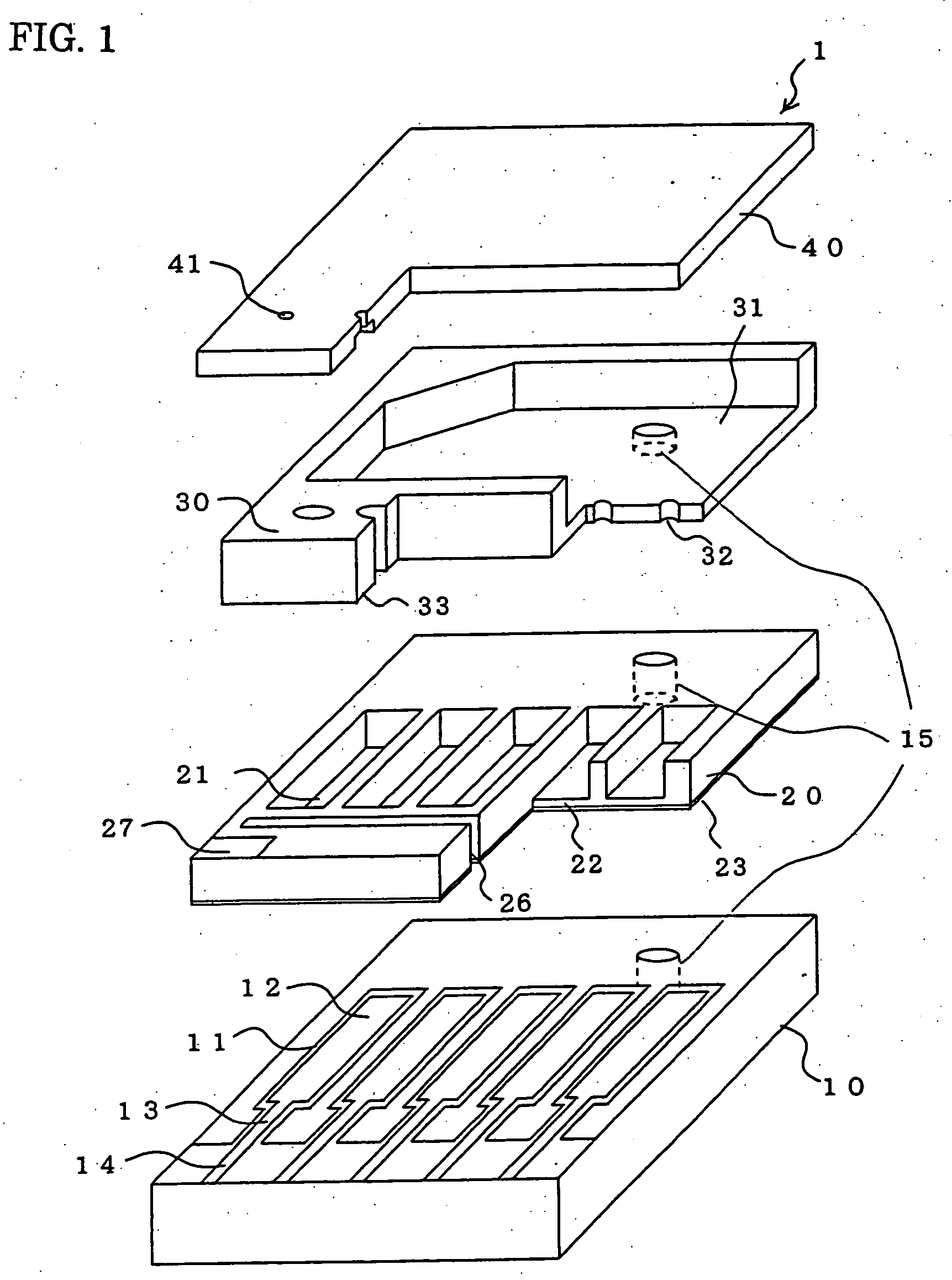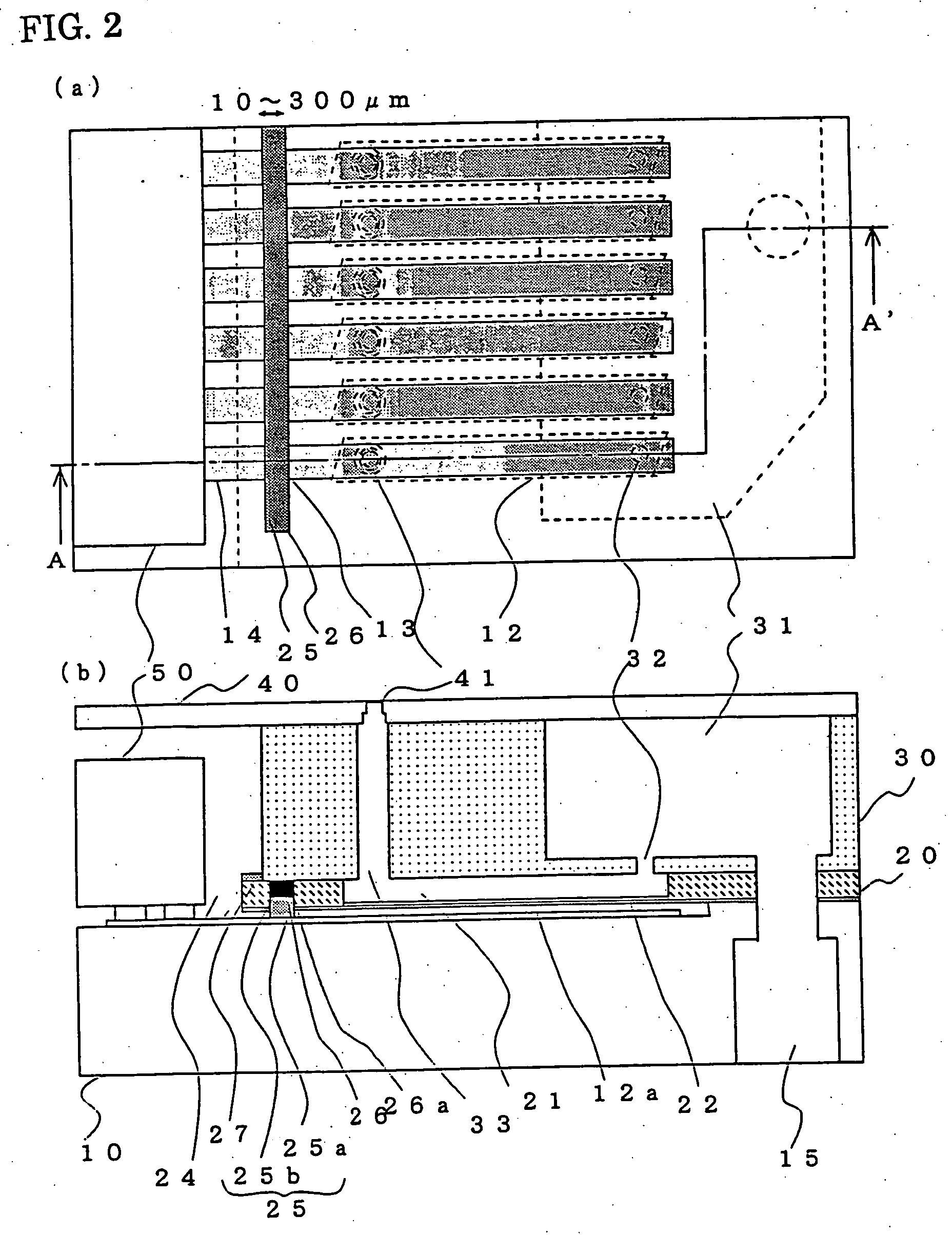Electrostatic actuator, droplet discharging head, droplet discharging apparatus, electrostatic device, and method of manufacturing these
a technology of electrostatic actuators and actuators, which is applied in the field of electrostatic actuators, droplet discharging heads, droplet discharging apparatuses, and methods of manufacturing these. it can solve the problems of inability to control the capillary action, difficulty in miniaturizing the ink jet head, and different sealing conditions
- Summary
- Abstract
- Description
- Claims
- Application Information
AI Technical Summary
Benefits of technology
Problems solved by technology
Method used
Image
Examples
first embodiment
[0107]FIG. 1 is an exploded view of a droplet discharging head according to a first embodiment of the invention. FIG. 1 shows a part of the droplet discharging head. In addition, FIG. 2 is a top plan view and a vertical sectional view of the droplet discharging head, respectively. In this embodiment, there is illustrated a face-eject type droplet discharging head as a representative of devices which use an electrostatic actuator driven in an electrostatic manner. (Moreover, the following drawings including FIG. 1 may not provide actual dimensions of respective constitutional members in order to facilitate visualization of the illustrated constitutional members. Each of these drawings shows the constitutional elements while being kept upright.)
[0108] As shown in FIG. 1, a droplet discharging head according to this embodiment is constructed by four substrates of an electrode substrate 10, a cavity substrate 20, a reservoir substrate 30, and a nozzle substrate 40, which are laminated ...
second embodiment
[0132]FIG. 6 is a view showing a relationship between the through-slot 26 disposed in the cavity substrate 20 and the lead portion 13 disposed on the electrode substrate 10, according to a second embodiment of the invention. The above-mentioned first embodiment is illustrated assuming that the sealing material 25 is not adhered to a bonded surface between the cavity substrate 20 and the reservoir substrate 30. However, in the case where the attached silicon mask is separated from the cavity substrate 20 by a gap without close contact, or the alignment of the silicon mask is off, for example, it cannot be said that the sealing material 25 is not adhered to the bonded surface. Even if this happens, in this embodiment, a sealing material clearance groove 34 being preliminarily formed on the reservoir substrate 30 prevents the sealing material 25 from contacting the reservoir substrate 30, which prevents the poor bonding.
[0133] On this occasion, the sealing material clearance groove 34...
third embodiment
[0143] In the above-mentioned embodiment, the TEOS layer 25a and the moisture permeation preventing layer 25b are employed as the sealing material 25. Oxide silicon is the best material because it is superior in the resistance to liquid or gas which is used in the subsequent processes, but is not limited thereto. Further, the moisture permeation preventing layer 25b may include, for example, not only Al2O3 (aluminum oxide (alumina)), but also silicon nitride (SiN) and silicon oxynitride (SiON). Also, it may include substances, such as Ta2O5 (tantalum pentoxide), DLC (diamond like carbon), polyparaxylylene, PDMS (polydimethylsilxane: a kind of silicone rubber), an inorganic or organic compound including epoxy resin, etc., which are relatively lower in molecular mass and can be deposited by means of a vapor deposition method, a sputtering method, etc., and further are impermeable to moisture. Generally, the inorganic compound material is superior in a gas barrier property, a vapor bar...
PUM
 Login to View More
Login to View More Abstract
Description
Claims
Application Information
 Login to View More
Login to View More - R&D
- Intellectual Property
- Life Sciences
- Materials
- Tech Scout
- Unparalleled Data Quality
- Higher Quality Content
- 60% Fewer Hallucinations
Browse by: Latest US Patents, China's latest patents, Technical Efficacy Thesaurus, Application Domain, Technology Topic, Popular Technical Reports.
© 2025 PatSnap. All rights reserved.Legal|Privacy policy|Modern Slavery Act Transparency Statement|Sitemap|About US| Contact US: help@patsnap.com



